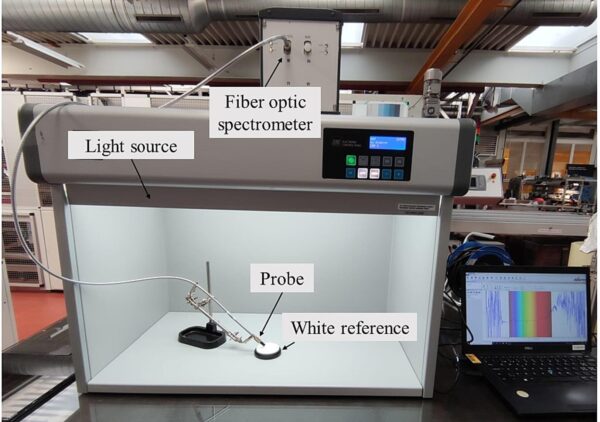Researchers from Switzerland have developed a novel color characterization technique for building-integrated photovoltaics (BIPV).
The method, dubbed large area illumination (LAI) colorimeter, uses a fiber optic spectrometer and large area illumination. With that, it can overcome the issues of existing color characterization techniques, which struggle to accurately determine color when it is behind a transparent layer, such as a solar PV laminate.
“We are currently working on enhancing the method by testing light sources and designing a portable device to characterize the color of BIPV modules,” corresponding author Alejandro Borja Block told pv magazine. “We are studying light sources, and calibration procedures, and proposing a suitable portable tool.”
The novel LAI method uses an optical fiber spectrometer to detect color characterization signals. It was positioned at a 45-degree angle relative to the samples and 7 mm above their rear side. As the measurements depend on the lightning, the illuminated area must be greater than the measuring spot. To achieve that, the researchers used a diffuse lamp with a visible spectrum signal similar to D65, which roughly corresponds to the average midday light in Western and Northern Europe.
To prove the utility of the new method, the scientists measured the differences in color measurement between color foils without glass and with glass thicknesses of 3.2 mm and 6.4 mm. They did this over eight different foil types, ranging from high-reflective white to low-reflective clay. Then, they compared the differences detected by the novel method to those detected by existing color characterization techniques – a scanner, a portable colorimeter, and an integrated sphere spectrometer.

Image: École Polytechnique Fédérale de Lausanne (EPFL), Solar Energy, CC BY 4.0 DEED
“These devices produce accurate reflectance measurements when the samples under investigation are positioned in the aperture of the integrating sphere or the colorimeter,” they emphasized. “In the case of integrated PV modules, the front layer is based on several-millimeter-thick glass, which creates measurement artifacts. The above-mentioned devices send a light probe through their aperture to process the signal. A reduction in reflectance is observed due to the thickness of the transparent layer.”
According to their findings, when using the LAI method, the signal is only slightly decreased when changing the sample from free foil to glassed foil. Compared to that, and with the same samples, a high reflectance reduction is found with the integrated sphere spectrometer and the portable colorimeter. For example, while the commercial portable colorimeter had measured the color change at 57, the results of the LAI were only 3.
In addition, the scientists also found that standard scanner machines cannot accurately assess colors in PV modules because the light is trapped in the glass. “The measurements comparing the characterization techniques indicate that the LAI colorimeter performs much better than the commercially available solutions in terms of accuracy,” the research group highlighted.
Its findings were presented in “Accurate color characterization of solar photovoltaic modules for building integration,” published on Solar Energy. The scientists come from the École Polytechnique Fédérale de Lausanne (EPFL) and the Swiss Center for Electronics and Microtechnology (CSEM).
This content is protected by copyright and may not be reused. If you want to cooperate with us and would like to reuse some of our content, please contact: editors@pv-magazine.com.



By submitting this form you agree to pv magazine using your data for the purposes of publishing your comment.
Your personal data will only be disclosed or otherwise transmitted to third parties for the purposes of spam filtering or if this is necessary for technical maintenance of the website. Any other transfer to third parties will not take place unless this is justified on the basis of applicable data protection regulations or if pv magazine is legally obliged to do so.
You may revoke this consent at any time with effect for the future, in which case your personal data will be deleted immediately. Otherwise, your data will be deleted if pv magazine has processed your request or the purpose of data storage is fulfilled.
Further information on data privacy can be found in our Data Protection Policy.